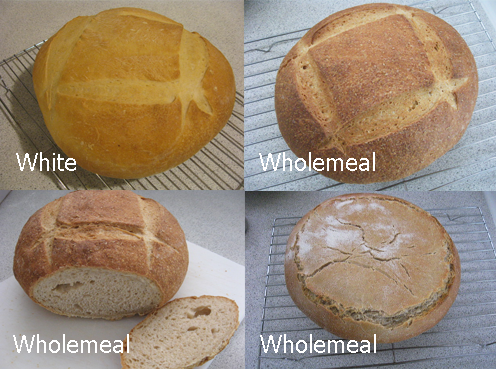I cooked two loaves in the weekend. One was white and one wholemeal. I used the same recipe but adjusted it by adding half the flour as wholemeal to get the wholemeal loaf. I was happy with the loaves, but when I turned the wholemeal one over I noticed cracking all the way around the base. I cooked it in a fan forced oven on a pizza stone and a pan of boiling water at the bottom of the oven. What caused the cracks/splits? Was it under proofing?

I'd be interested in your comments as I'm learning so much as I go.
Thanks
Wannabbaker :)
crust baking it before it could stretch completely... the dough surface was too dry when it went into the oven preventing it from stretching. Under-proofed means a little more proofing needs to stretch the volume of the loaf just a bit more before baking. I think the problem here is not under-proofing.
I see too dry surface "skin" on the bottom of the loaf as it went into the steamy oven. If you were to set the baked loaf upside-down loaf back into the banneton, the source might become obvious. Notice that the cracks are where the edge of the shaped dough meet the banneton? I think the exposed area of the dough while resting in the banneton dried out too much during the proofing.
Examine where and what is being done with the dough as it rises in the banneton. Is it covered? Dusted and covered? Open in low humidity? In a draft? Whole meal will split easier than white wheat due to bran particles cutting the gluten matrix during expansion so it is important to keep your loaf skin optimal and balanced with what is happening with the skin touching the banneton.
What to do if you see this again while turning out a loaf from a banneton? Don't panic and enjoy the ring around your loaf bottom or:
Try misting the dry skin and let it soften before flipping out or score the surface so it becomes part of the loaf design/decoration. A score that eventually wraps around the loaf. A spiral or palm leaf or #?
Yes, you read right, I mean score the bottom of the loaf. Not often done or thought about but it might be fun and even enlightening! :) "no guts, no glory!"
Mini
Hi Mini
Thanks for your reply. Yes, the loaves were enjoyed by the family irrespective of the cracks.
My banneton is a glass bowl lined with a cloth and dusted with flour, and yes the cracks were at the corner of the bowl (why didn't I notice that). So next time I'll try misting both sides of the loaf after proofing and before going in the steamy oven. I'll see how it goes and then maybe risk scoring the bottom of the loaf ;)
I may have to bake midweek just to try out these possibilities - this baking is addictive! :)
Wannabbaker
one loaf after the other or both at the same time?
Hi Juergen
I baked these two loaves on different days. I wondered if the temperature of the pizza stone I use has something to do with it. Could it be that I didn't put the stone in the oven for long enough to heat up before I removed it to put the dough on?
Thanks
Wannabbaker
Happy Baking,
Juergen
don't use convection while you steam. Use regular bake. When the steam comes out after 10-15 minutes of baking, then turn the oven down 25 F and use convection for the rest of the bake. You might want to use Sylvia's steaming method too with your current method of steam. more steam = better spring, bloom, and rise in the ovenSylvia's steam is to use a loaf pan 1/2 full of hot tap water with a rolled up dish towel in it. Put it n the the bottom rack of the the oven when you start your pre heat, with the stone the next rack higher.
Your stone will be 20 minutes behind your oven heat. When your oven hits 500 F your stone will be 20 minutes behind it. A good way to preheat is to let your oven hit the desired temp and then wait 20 minutes.
Nice baking regardless of a little cracking.
Hi dabrownman
Thanks for the great tip on the stone being 20 minutes behind the oven. I haven't had it in the oven for anywhere near that time to heat up. I can see a few changes to my baking routine already :)
I appreciate your comments.